Abstract
The sensitivity and specificity of a urinary pregnanediol-3-glucuronide (PdG) ratio algorithm to identify anovulatory cycles was studied prospectively in two independent populations of women. Urinary hormone data from the first group was used to develop the algorithm, and data from the second group was used for its validation. PdG ratios were calculated by a cycles method in which daily PdG concentrations indexed by creatinine (CR) from cycle day 11 onward were divided by a baseline PdG (average PdG/Cr concentration for cycle days 6-10). In the interval method, daily PdG/CR concentrations from day 1 onward were divided by baseline PdG (lowest 5-day average of PdG/CR values throughout the collection period). Evaluation of the first study population (n = 6) resulted in cycles with PdG ratios > or = 3 for > or = 3 consecutive days being classified as ovulatory; otherwise they were anovulatory. The sensitivity and specificity of the PdG ratio algorithm to identify anovulatory cycles in the second population were 75% and 89.5%, respectively, for all cycles (n = 88); 50% and 88.3% for first cycles (n = 40) using the cycles method; 75% and 92.2%, respectively, for all cycles (n = 89); and 50% and 94.1% for first cycles (n = 40) using the interval method. The "gold standard" for anovulation was weekly serum samples < or = 2 ng/ml progesterone. The sensitivity values for all cycles and for the first cycle using both methods were underestimated because of apparent misclassification of cycles using serum progesterone due to infrequent blood collection. Blood collection more than once a week would have greatly improved the sensitivity and modestly improved the specificity of the algorithm. The PdG ratio algorithm provides an efficient approach for screening urine samples collected in epidemiologic studies of reproductive health in women.
Full text
PDF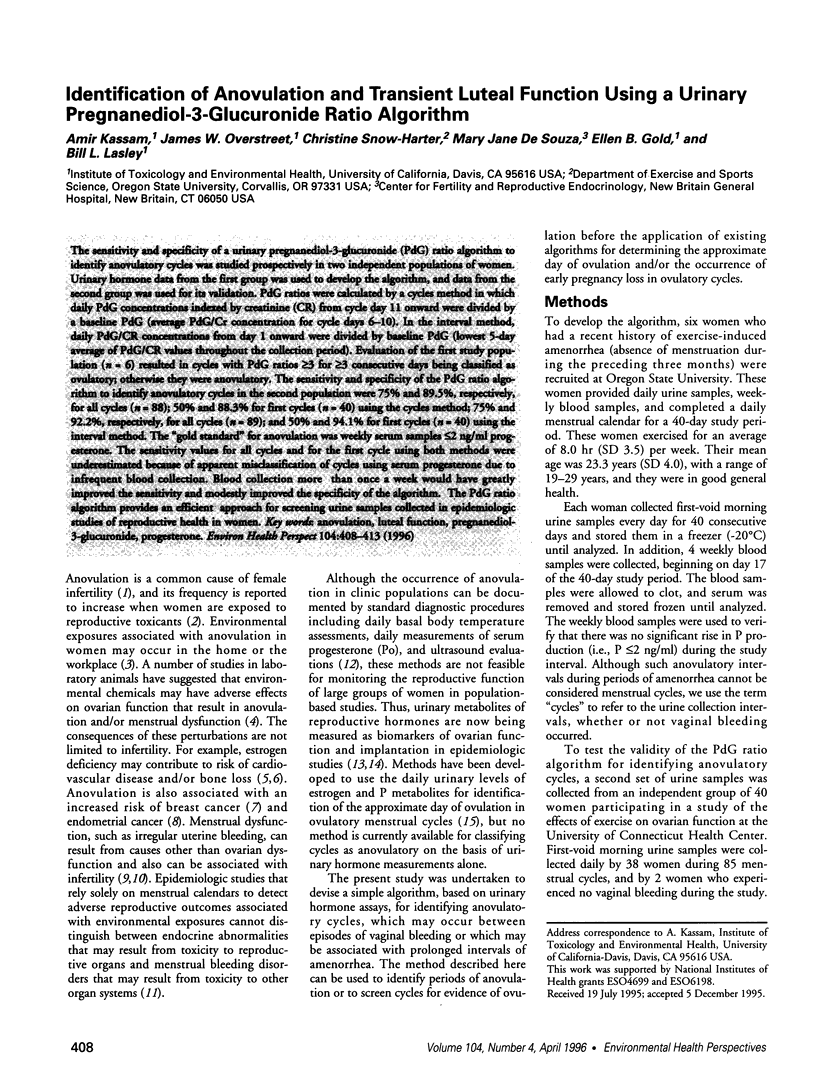
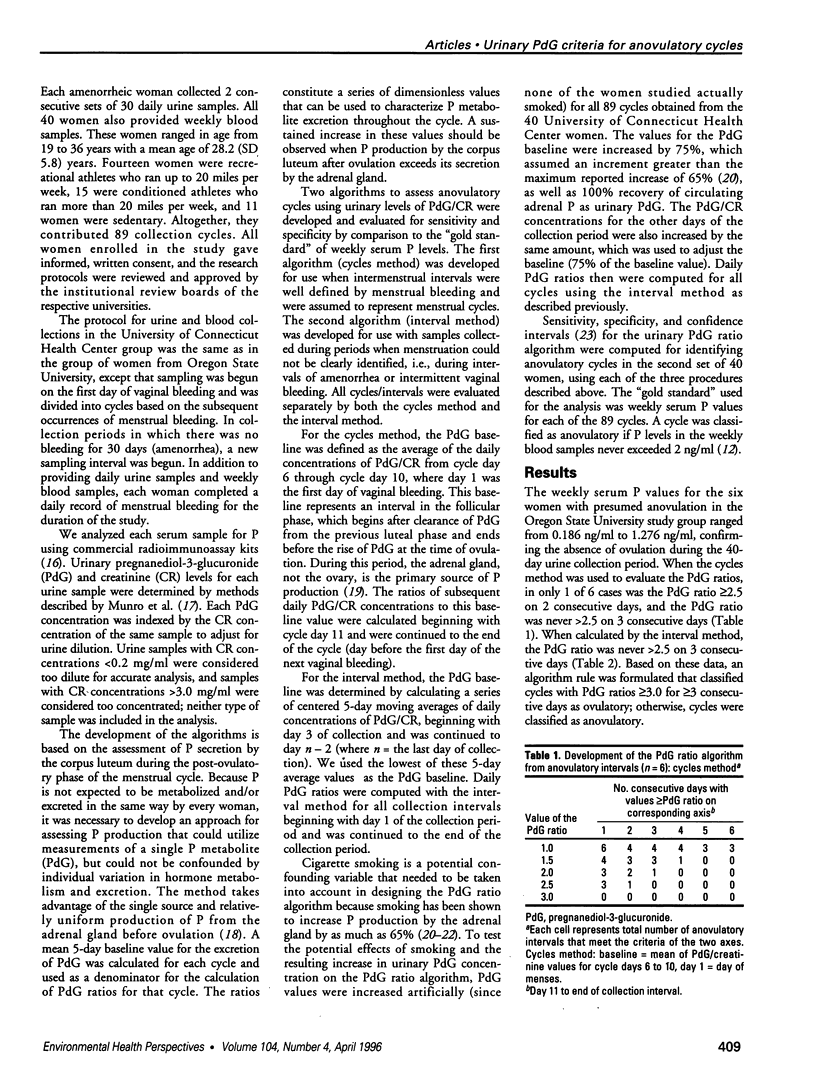
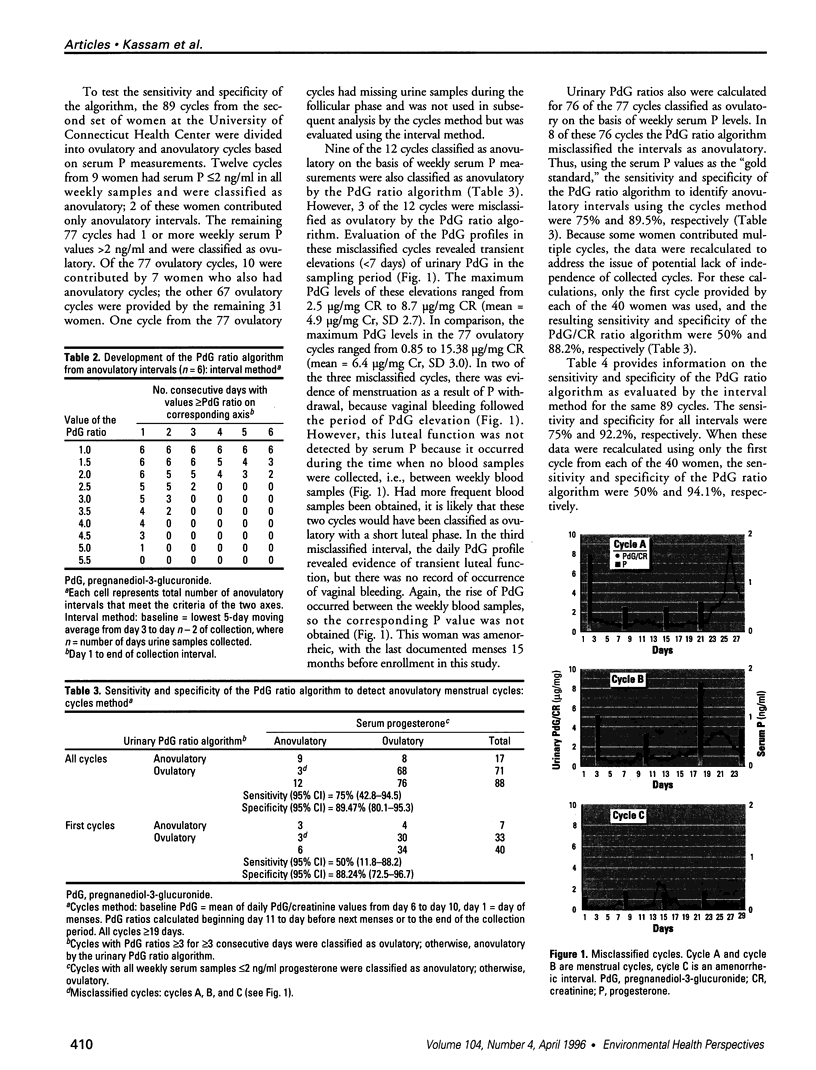
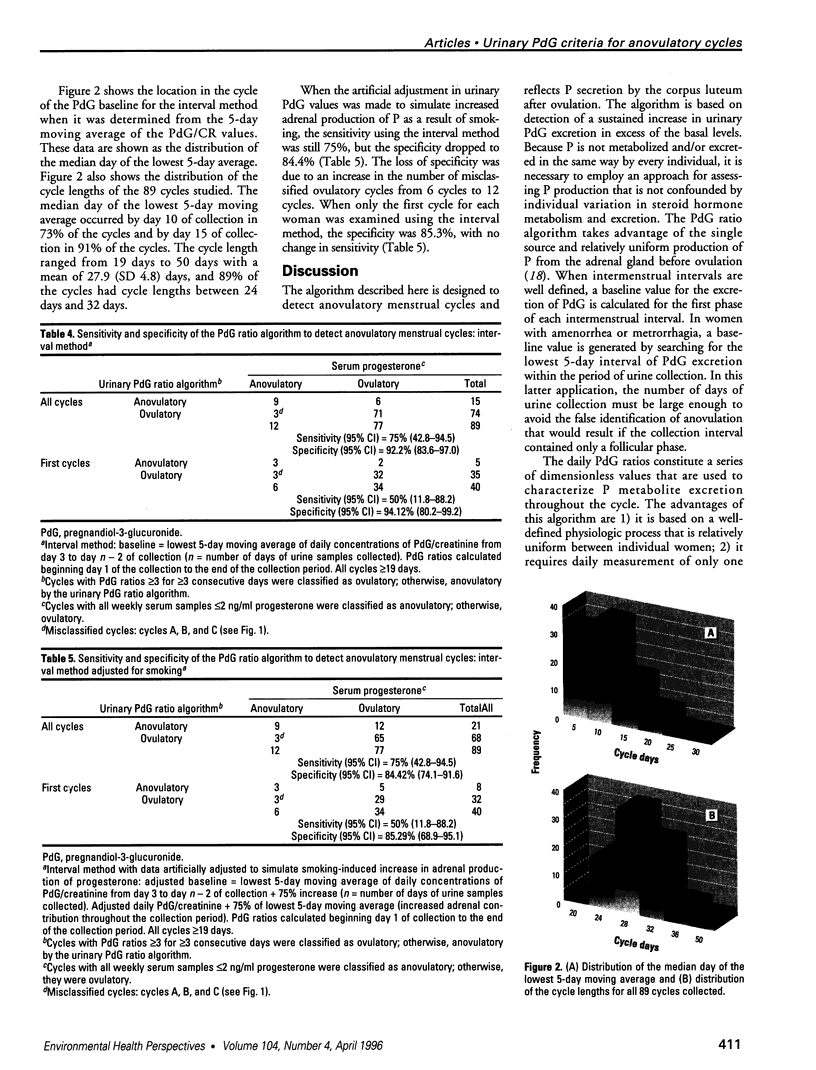

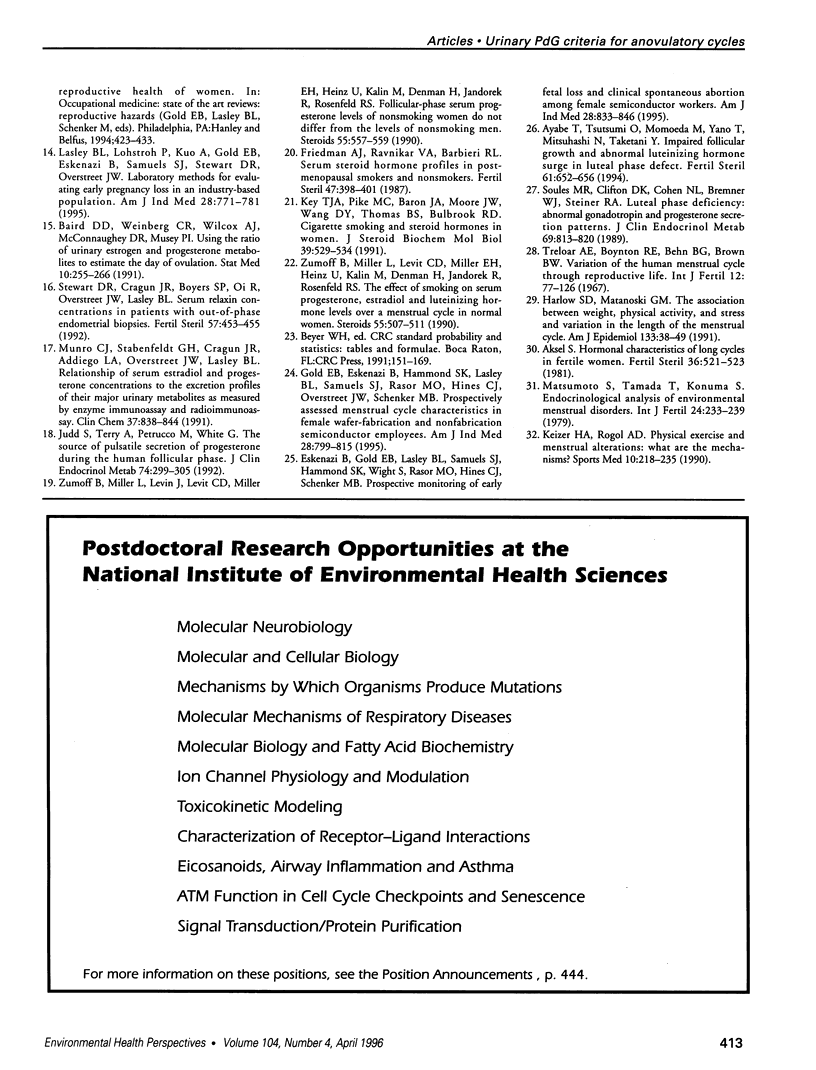
Images in this article
Selected References
These references are in PubMed. This may not be the complete list of references from this article.
- Aksel S. Hormonal characteristics of long cycles in fertile women. Fertil Steril. 1981 Oct;36(4):521–523. doi: 10.1016/s0015-0282(16)45805-x. [DOI] [PubMed] [Google Scholar]
- Askalani H., Smuk M., Sugar J., Delvoye P., Robyn C., Schwers J. Serum progesterone in nonpregnant women. I. Comparative study of serum progesterone concentration and urinary pregnanediol excretion. Am J Obstet Gynecol. 1974 Apr 15;118(8):1054–1063. [PubMed] [Google Scholar]
- Ayabe T., Tsutsumi O., Momoeda M., Yano T., Mitsuhashi N., Taketani Y. Impaired follicular growth and abnormal luteinizing hormone surge in luteal phase defect. Fertil Steril. 1994 Apr;61(4):652–656. doi: 10.1016/s0015-0282(16)56641-2. [DOI] [PubMed] [Google Scholar]
- Baird D. D., Weinberg C. R., Wilcox A. J., McConnaughey D. R., Musey P. I. Using the ratio of urinary oestrogen and progesterone metabolites to estimate day of ovulation. Stat Med. 1991 Feb;10(2):255–266. doi: 10.1002/sim.4780100209. [DOI] [PubMed] [Google Scholar]
- De Rosis F., Anastasio S. P., Selvaggi L., Beltrame A., Moriani G. Female reproductive health in two lamp factories: effects of exposure to inorganic mercury vapour and stress factors. Br J Ind Med. 1985 Jul;42(7):488–494. doi: 10.1136/oem.42.7.488. [DOI] [PMC free article] [PubMed] [Google Scholar]
- Drinkwater B. L., Nilson K., Chesnut C. H., 3rd, Bremner W. J., Shainholtz S., Southworth M. B. Bone mineral content of amenorrheic and eumenorrheic athletes. N Engl J Med. 1984 Aug 2;311(5):277–281. doi: 10.1056/NEJM198408023110501. [DOI] [PubMed] [Google Scholar]
- Eskenazi B., Gold E. B., Lasley B. L., Samuels S. J., Hammond S. K., Wight S., O'Neill Rasor M., Hines C. J., Schenker M. B. Prospective monitoring of early fetal loss and clinical spontaneous abortion among female semiconductor workers. Am J Ind Med. 1995 Dec;28(6):833–846. doi: 10.1002/ajim.4700280615. [DOI] [PubMed] [Google Scholar]
- Fraser I. S. Menorrhagia--a pragmatic approach to the understanding of causes and the need for investigations. Br J Obstet Gynaecol. 1994 Jul;101 (Suppl 11):3–7. doi: 10.1111/j.1471-0528.1994.tb13688.x. [DOI] [PubMed] [Google Scholar]
- Friedman A. J., Ravnikar V. A., Barbieri R. L. Serum steroid hormone profiles in postmenopausal smokers and nonsmokers. Fertil Steril. 1987 Mar;47(3):398–401. [PubMed] [Google Scholar]
- Gidwani G. P. Gynecologic problems of androgen excess. Cleve Clin J Med. 1990 May;57(3):288–291. doi: 10.3949/ccjm.57.3.288. [DOI] [PubMed] [Google Scholar]
- Gold E. B., Eskenazi B., Hammond S. K., Lasley B. L., Samuels S. J., O'Neill Rasor M., Hines C. J., Overstreet J. W., Schenker M. B. Prospectively assessed menstrual cycle characteristics in female wafer-fabrication and nonfabrication semiconductor employees. Am J Ind Med. 1995 Dec;28(6):799–815. doi: 10.1002/ajim.4700280613. [DOI] [PubMed] [Google Scholar]
- Harlow S. D., Matanoski G. M. The association between weight, physical activity, and stress and variation in the length of the menstrual cycle. Am J Epidemiol. 1991 Jan;133(1):38–49. doi: 10.1093/oxfordjournals.aje.a115800. [DOI] [PubMed] [Google Scholar]
- Judd S., Terry A., Petrucco M., White G. The source of pulsatile secretion of progesterone during the human follicular phase. J Clin Endocrinol Metab. 1992 Feb;74(2):299–305. doi: 10.1210/jcem.74.2.1730808. [DOI] [PubMed] [Google Scholar]
- Keizer H. A., Rogol A. D. Physical exercise and menstrual cycle alterations. What are the mechanisms? Sports Med. 1990 Oct;10(4):218–235. doi: 10.2165/00007256-199010040-00002. [DOI] [PubMed] [Google Scholar]
- Key T. J., Pike M. C., Baron J. A., Moore J. W., Wang D. Y., Thomas B. S., Bulbrook R. D. Cigarette smoking and steroid hormones in women. J Steroid Biochem Mol Biol. 1991 Oct;39(4A):529–534. doi: 10.1016/0960-0760(91)90247-3. [DOI] [PubMed] [Google Scholar]
- LaRosa J. C. Lipids and cardiovascular disease: do the findings and therapy apply equally to men and women? Womens Health Issues. 1992 Summer;2(2):102–113. doi: 10.1016/s1049-3867(05)80278-6. [DOI] [PubMed] [Google Scholar]
- Lasley B. L., Lohstroh P., Kuo A., Gold E. B., Eskenazi B., Samuels S. J., Stewart D. R., Overstreet J. W. Laboratory methods for evaluating early pregnancy loss in an industry-based population. Am J Ind Med. 1995 Dec;28(6):771–781. doi: 10.1002/ajim.4700280611. [DOI] [PubMed] [Google Scholar]
- Matsumoto S., Tamada T., Konuma S. Endocrinological analysis of environmental menstrual disorders. Int J Fertil. 1979;24(4):233–239. [PubMed] [Google Scholar]
- Munro C. J., Stabenfeldt G. H., Cragun J. R., Addiego L. A., Overstreet J. W., Lasley B. L. Relationship of serum estradiol and progesterone concentrations to the excretion profiles of their major urinary metabolites as measured by enzyme immunoassay and radioimmunoassay. Clin Chem. 1991 Jun;37(6):838–844. [PubMed] [Google Scholar]
- Secreto G., Zumoff B. Abnormal production of androgens in women with breast cancer. Anticancer Res. 1994 Sep-Oct;14(5B):2113–2117. [PubMed] [Google Scholar]
- Shortridge L. A. Assessment of menstrual variability in working populations. Reprod Toxicol. 1988;2(3-4):171–176. doi: 10.1016/0890-6238(88)90018-4. [DOI] [PubMed] [Google Scholar]
- Soules M. R., Clifton D. K., Cohen N. L., Bremner W. J., Steiner R. A. Luteal phase deficiency: abnormal gonadotropin and progesterone secretion patterns. J Clin Endocrinol Metab. 1989 Oct;69(4):813–820. doi: 10.1210/jcem-69-4-813. [DOI] [PubMed] [Google Scholar]
- Stewart D. R., Cragun J. R., Boyers S. P., Oi R., Overstreet J. W., Lasley B. L. Serum relaxin concentrations in patients with out-of-phase endometrial biopsies. Fertil Steril. 1992 Feb;57(2):453–455. [PubMed] [Google Scholar]
- Treloar A. E., Boynton R. E., Behn B. G., Brown B. W. Variation of the human menstrual cycle through reproductive life. Int J Fertil. 1967 Jan-Mar;12(1 Pt 2):77–126. [PubMed] [Google Scholar]
- Zumoff B., Miller L., Levin J., Levit C. D., Miller E. H., Heinz U., Kalin M., Denman H., Jandorek R., Rosenfeld R. S. Follicular-phase serum progesterone levels of nonsmoking women do not differ from the levels of nonsmoking men. Steroids. 1990 Dec;55(12):557–559. doi: 10.1016/0039-128x(90)90052-d. [DOI] [PubMed] [Google Scholar]
- Zumoff B., Miller L., Levit C. D., Miller E. H., Heinz U., Kalin M., Denman H., Jandorek R., Rosenfeld R. S. The effect of smoking on serum progesterone, estradiol, and luteinizing hormone levels over a menstrual cycle in normal women. Steroids. 1990 Nov;55(11):507–511. doi: 10.1016/0039-128x(90)90089-t. [DOI] [PubMed] [Google Scholar]







